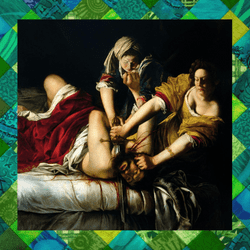I must say that I struggled quite a bit trying to think of a girlhood heroine or any hero of mine when asked to write on this topic.Throughout my life, even as a child, I didn’t particularly idolise anyone. Certainly, I enjoyed watching cartoons, tv shows, movies or reading books with girl and women characters, and nowadays there are a lot of remarkable women whose feats I admire but I never truly thought of anyone as a personal hero of mine. For this reason, I remember I often found it painstakingly difficult trying to write on this topic for school assignments as a child regardless of the hero’s gender. And thus, this personal dilemma has once again come back to make life difficult for me.
However, today I remembered that perhaps there was someone that does fit these heroine requirements. I discovered this person a little bit later than early girlhood, around the age of 15. I watched a BBC documentary about the life and art of the talented Baroque painter, Artemisia Gentileschi and it was an astonishing experience. I was truly mesmerised by her paintings and stylistic abilities. I was quite interested in art myself and loved painting all throughout school. Rather than the more conceptual and modern art of the 20th century, I was more drawn towards realism and in particular the dark nature, chiaroscuro, of Baroque art. It was around this age that I had also discovered Rubens and Caravaggio who remain on my list of favourite painters until this day. And so I was truly shocked to find out that there was a painter who could be an admirable rival to the famed Baroque Masters but she was not a man but a woman! I must have been sitting with my mouth open the whole time whilst watching that documentary. Her paintings are filled with so much drama and a critique on men in 17th century society which is unlike other art of the time. The women are often portrayed with compassion when they are being mistreated by men such as in Susanna and the Elders (1610) painted at age 17, where the men are clearly intruding on the young woman’s private bath time, or by contrast her women are presented as strong-willed, fearless characters with calculative missions found in Judith Slaying Holofernes (1613). Stylistically, Gentileschi is a gifted painter and it’s quite sad that she had been forgotten from art history and only rediscovered in the 20th century.
However, to be a gifted painter was only the first step in attaining success. There were many complex restrictions reinforced upon women and thus there were not many women painters during this time at all. Not only did Artemisia have to overcome the societal expectations bestowed on women at the time – living at home as housewives and raising children, women were likewise not allowed to become painters as they were banned from drawing nudes, and it was seen as a ‘dirty and messy’ profession for ladies to engage in. However, Gentileschi was thankfully encouraged by her father Orazio who, likewise, was a painter and saw his daughter’s potential. Yet, a further difficult event occured when Artemisia was raped by a now largely forgotten artist Agostino Tassi. Artemesia had to stand in trial and publically testify as a victim against him which at the time perhaps brought more societal shame than compassion upon her family. Yet, Artemisia Gentileschi was able to channel this traumatising experience into her art and this could explain why, at times, her painting depicts violence towards men and always sides with the women characters.
Uncovering all of Artemisia’s story during my teenage years was most definitely a formative experience and made me feel inspired by this woman’s (or more accurate teenage girl’s) strong and courageous journey in all facets of her life – personal and professional. She could persevere in a completely male-dominated profession during a time when it was simply unheard of for women to have any kinds of roles outside of the house, nevermind such an influential one. I am adamant that her painting and her story influenced me greatly and became a huge reason as to why I wanted to study art history at university, although I may not have realised that then. And so, as a current art historian I hope that we will continue to harvest girl talents and discover a lot more promising art by strong women artists who deserve to be seen.
-Kat Kavaliova
Junior Girl
Girl Museum Inc.

